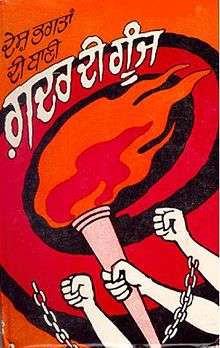Silk Letter Movement
The Silk Letter Movement (تحریکِ ریشمی رومال) refers to a movement organised by the Deobandi leaders between 1913 and 1920, aimed at freeing India from the British rule by allying with Ottoman Turkey, Imperial Germany, and Afghanistan. The plot was uncovered by Punjab CID with the capture of letters from Ubaidullah Sindhi, one of the Deobandi leaders then in Afghanistan, to Mahmud al Hasan, another leader then in Persia. The letters were written in silk cloth, hence the name.[1][2]
Muhammad Mian Mansoor Ansari went to Hejaz with Mahmood Hasan in September 1915. He returned to India in April 1916 with Ghalib Nama (Silk Letter) which he showed to freedom fighters in India and the autonomous area and then took it to Kabul where he reached in June 1916.[3]
With the onset of World War I, Ubaidullah Sindhi and Mehmud Hasan (principal of the Darul Uloom Deoband) had proceeded to Kabul in October 1915 with plans to initiate a Muslim insurrection in the tribal belt of India. For this purpose, Ubaid'Allah was to propose that the Amir of Afghanistan declares war against Britain while Mahmud al Hasan sought German and Turkish help. Hasan proceeded to Hijaz. Ubaid Allah, in the meantime, was able to establish friendly relations with Amir. As the plans unfolded in what came to be called the Silk Letter movement, Ubaid'Allah was able to establish friendly relations with Amir. At Kabul, Ubaid'Allah, along with some students who had preceded him to make way to Turkey to join the Caliph's "Jihad" against Britain, decided that the pan-Islamic cause was to be best served by focussing on the Indian Freedom Movement.[4]
The Berlin-Indian committee (which became the Indian Independence Committee after 1915) also resulted in an Indo-German-Turkish mission to the Indo-Iranian border to encourage the tribes to strike against British interests.[5][6] This group met the Deobandis in Kabul in December 1915. The mission, along with bringing members of the Indian movement right to India's border, also brought messages from the Kaiser, Enver Pasha and the displaced Khedive of Egypt, Abbas Hilmi expressing support for Pratap's mission and inviting the Amir to move against India[7][8]
The mission's immediate aim was to rally the Amir against British India[7] and to obtain from the Afghan Government a right of free passage.[9] But after the leakage of the plan, the top Deobandi leaders were arrested—Mahmudul-Hasan was arrested from Makkah and together with Husayn Ahmad, was exiled to Malta, from where, he was released in his later stages of T.B.
In January 2013, The President of India, Pranab Mukherjee released a commemorative postage stamp on the Silk Letter Movement to acknowledge and appreciate the sacrifices of such groups for the Indian independence movement.[10]
Notes
- ↑ Pan-Islam in British Indian Politics: A Study of the Khilafat Movement, 1918-1924.(Social, Economic and Political Studies of the Middle East and Asia). M. Naeem Qureshi. p79,80,81,82
- ↑ Sufi Saints and State Power: The Pirs of Sind, 1843-1947.Sarah F. D. Ansari.p82
- ↑ http://www.darululoom-deoband.com/urdu/books/tmp/1388990860%20Silk%20Letter%20Movement.pdf
- ↑ Ansari 1986, p. 515
- ↑ Ansari 1986, p. 514
- ↑ Strachan 2001, p. 788
- 1 2 Sims-Williams 1980, p. 120
- ↑ Seidt 2001, p. 1,3
- ↑ Ansari 1986, p. 516
- ↑ http://pib.nic.in/newsite/PrintRelease.aspx?relid=91529
References
- Muhammad Miyan /Muhammadullah Qasmi, Moulana (2013), Silk Letter Movement (2013), Manak Publications, Pvt. Ltd. New Delhi, ISBN 978-93-7831-322-6.
- Ansari, K. H. (1986), Pan-Islam and the Making of the Early Indian Muslim Socialist. Modern Asian Studies, Vol. 20, No. 3. (1986), pp. 509-537, Cambridge University Press.
- Seidt, Hans-Ulrich (2001), From Palestine to the Caucasus-Oskar Niedermayer and Germany's Middle Eastern Strategy in 1918.German Studies Review, Vol. 24, No. 1. (Feb., 2001), pp. 1-18, German Studies Association, ISSN 0149-7952.
- Sims-Williams, Ursula (1980), The Afghan Newspaper Siraj al-Akhbar. Bulletin (British Society for Middle Eastern Studies), Vol. 7, No. 2. (1980), pp. 118-122, London, Taylor & Francis Ltd, ISSN 0305-6139.
- Strachan, Hew (2001), The First World War. Volume I: To Arms, Oxford University Press. USA, ISBN 0-19-926191-1.
- M .E. Yapp, "That Great Mass of Unmixed Mahomedanism": Reflections on the Historical Links between the Middle East and Asia, British Journal of Middle Eastern Studies, Vol. 19, No. 1. (1992), pp. 3–15.
- M. Naeem Qureshi, The 'Ulamā' of British India and the Hijrat of 1920, Modern Asian Studies, Vol. 13, No. 1. (1979), pp. 41–59.
- Silk Letter Movement(PDF)
